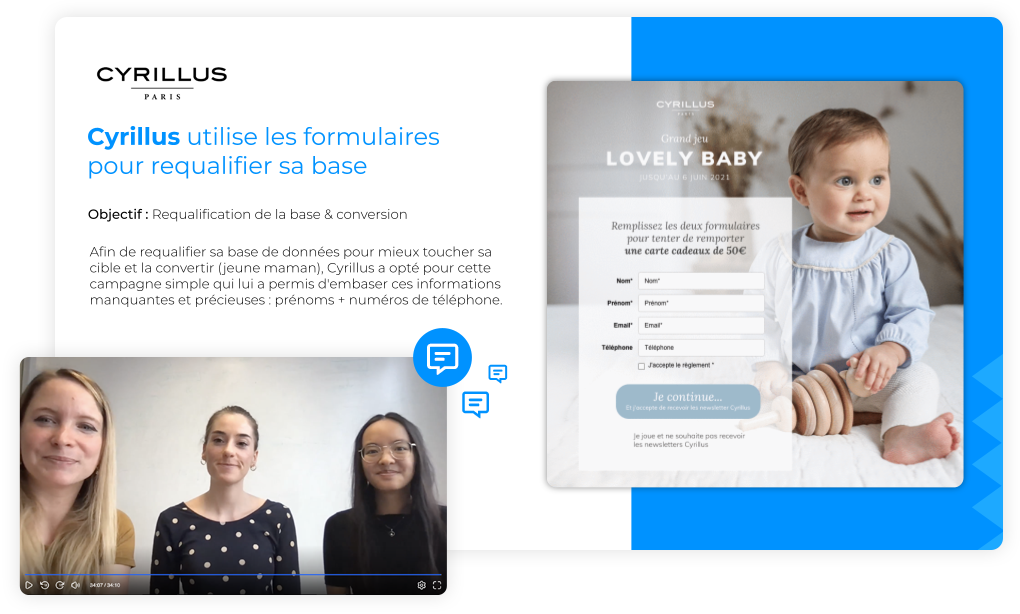
Harness the potential of your data with segmentation
In an increasingly data-driven world, understanding and exploiting the potential of your collected data is essential to achieving your marketing objectives. Segmentation is one of the keys to achieving this. By fully understanding the importance of marketing segmentation and applying it on a daily basis, you will be able to maximise the performance of your gamification campaigns.
In this article, we’ll explore the different facets of segmentation and its practical application in marketing. We’ll guide you through the use of our new Segment functionality, which will enable you to guide your prospects along an ideal patch to purchase or engagement.
get ready to explore the incredible opportunities that segmentation can offer you.
Understanding the importance of marketing segmentation
Marketing segmentation involves dividing your audience into homogeneous groups. These groups, known as segments, are formed on the basis of common characteristics such as:
- preferences
- behaviours
- needs
The main aim of segmentation is to enable targeted and personalised communication. By sending specific messages to each segment.
Segmentation, ideal for boosting engagement and conversion
By segmenting an audience, you can send personalised messages that correspond to the expectations and specific needs of each group. It is then possible to create marketing campaigns tailored to each segment. Using a language, tone, offers and content that resonate with them.
” 91% of consumers are more likely to buy from brands that recognise them, remember them and offer relevant offers and recommendations “.
By sending personalised offers and content that meet the expectations of each segment, you considerably increase the likelihood of engagement and conversion. Customers tend to be more receptive to relevant messages addressed directly to them, because they feel understood.
This practice genuinely improves the perceived relevance of messages. The result is an environment that is suitable to converting prospects into loyal customers.

Improving relations with prospects and customers
Strengthening the relationship with your customers and prospects is essential. Send personalised messages that take account of individual preferences. You’ll show your audience that you understand them and care about their specific needs. This fosters a feeling of closeness and trust. This can lead to increased customer loyalty and improved overall satisfaction.
Gaining a better understanding of the target audience
Marketing segmentation gives you a valuable opportunity to gain in-depth knowledge of your target audience. By analysing data relating to gamification campaigns, preferences and purchasing behaviour, you can gain valuable insights into your target audience.
These insights help you to refine your marketing strategy by better understanding the needs and expectations of each group. This means you can adjust your offer, communication channels, positioning and tactics to maximise the impact of your campaigns This in-depth knowledge of your target audience also enables you to identify new opportunities for growth, innovate and keep pace with market developments.
You are now familiar with segmentation in the strictest sense of the term. Now we can go even further in optimising your engagement and conversion objectives around your audience. With the new Segment functionality on the Adictiz Box platform.
Did you know? “55% of marketers believe that they do not have enough customer data to implement effective personalisation”
Segment, a game-changing feature for gamified campaigns
In our last online event on the quest for qualified leads, we gave you all the tips you need to collect data effectively in a gamification context. This is the first step in implementing your segmentation strategy. Without data, targeting is impossible.
Segment is a new and truly innovative feature on Adictiz. It allows you to create segments in your database. Collected via your various game campaigns, directly on the Adictiz platform.
Why is this interesting?
As an Adictiz customer, you can use the Segment function to:
- send specific messages to homogeneous groups of contacts
- being more responsive during or after the campaign to generate more engagement and conversions
- export segment data without handling global exports to feed your CRM
- improve relations with your customers and prospects
- get to know your audience better
Segment the data collected by your campaigns
In this example, let’s assume that your last Adictiz lead generation campaign is coming to an end. it’s a simple campaign consisting of a form (for data collection) and an instant win, Click Win . The game is very simple: all you have to do is click to discover the prize, which is distributed at random. Win or lose, the result is quickly revealed at the end of the game. At the end of your campaign, you have collected 10,000 subscribers, 45% of whom are opt-in (subscribers to your newsletter).
Our new functionality allows you to create up to 10 segments, based on more than 30 demographic and behavioural criteria:
- age
- sex
- localisation
- job
- social profile
- point of sale
- actions carried out on your campaign (like on a product, a visit to a specific page, etc.)
- specific informations extracted form a form

For example, you could create a segment of male contacts who have accepted the newsletter but not yet won a prize when they take part in your Click Win instant win.
The flexibility of the segmentation criteria means you can tailor your segments to your target audience and campaign objectives.
The data collected will depend on the path taken and its objective. Lead generation, product preferences, CRM database animation/qualification or traffic/sales generation. At Adictiz, we offer more than twenty pre-built campaigns to help you create your own sel-service campaigns.
A tool to improve responsiveness and performance
With the addition of the Segment functionality, Adictiz has been transformed into a complete platform for seamlessly collecting and activating data. You no longer need to juggle between our gamification tool and your CRM to ensure effective communication. Everything is integrated and centralised within our platform, simplifying your marketing operations. Of course, it’s also possible to export segment data without handling the overall export, so you can feed your CRM with pre-segmented data.
This complete integration means you can increase the efficiency and consistency of your marketing efforts. With all the tools you need at your fingertips, you can boost the performance of your campaigns. These include the recall of your products and services, engagement and loyalty rates, the number of accounts created and additional revenue.
“Consumers are looking for personalised marketing messages, with 72% saying they are only interested in content related to their specific interests.”
Greater relevance for your activations
Your campaign is underway or coming to an end, and your database is full of valuable information. You’ve segmented your audience strategically. Now it’s time for the crucial step: sending the most relevant messages to your segments based on their behaviour in your campaigns.
With the Adictiz e-mailing tool, you have a powerful feature at your disposal that allows you to create dedicated e-mails for each of your segments. This personalised approach allows you to optimise the relevance of your messages and significantly improve audience engagement.
“Customer fully connected to your brand are 52% more valuable than satisfied customers, while emotionally connected customers are 306% more valuable“.

This tools offers total flexibility for personalising the content of your e-mails according to the interests, preferences and specific actions of each segment. You can use dynamic variables to insert personalised elements. Such as the recipient’s name, product recommendations based on their purchase history or special offers based on their past interactions.
By using this targeted approach, you can provide each segment with information that really interests them. This will pique their interest and increase the chances of conversion. You can also put in place calls to action tailored to each segment, incitating them to engage more with your brand.
You have all the resources you need to create personalised, relevant e-mails. That capture your audience’s attention and encourage greater engagement. By personalising the content of your e-mails according to the behaviour of your segments, you increase the chances of conversion and build lasting relationships with your audience.
Case study: improve engagement and brand recall on your campaigns
Here’s a concrete example that illustrates the power of our new tool, Segment, in your objective to engage and memorise your brand with your audience.
Let’s say you choose to set up a campaign based on a score-based mechanics with an Outrun, a Glutton, a Megajump or a Tiny Wings.

Why opt for this approach? Quite simply because this type of mechanic encourages time spent with your band. The objective is simple: achieve the best score to win. This competition encourages users to replay and extend their playing time. This gives your brand greater visibility.
By offering a score-based mechanic, you create an interactive and addictive experience for your audience. Users will come back to improve their score and go beyond their own limits. This dynamic gameplay helps to create an emotional connection with your brand, making it even more memorable.
Following your campaign, you decide to create 3 segments:
Segment 1 : All users with a score <100 points who have not completed the route
For this audience, you can choose to send en email the next day (D+1). The goal is to encourage them to return and play again to complete the journey and try to achieve a better score.
You can motivate them by highlighting the rewards or benefits they could earn by improving their score.
This personalized communication will encourage these users to engage more with your brand and extent their gaming experience.

Segment 2 : All users with a score <100 points who have completed the journey.
For this audience, you also choose to send an email the next day (D+1). However, this time, the focus is on engaging them to return, play again, and score more points to increase their chances of participating in a raffle or lottery.
You can highlight the attractive rewards or prizes that can be won. By offering this additional opportunity, you boost user engagement and excitement. They will aim to improve their score to increase their chance of winning.
Segment 3 : All users with a score greater than > who have completed the journey and played more than once.

For this audience of high-performing players, you choose to send a thank-you email the following day (D+1). Congratulate them for being among the best players of the campaign. Take this opportunity to invite them to participate in a new exclusive gamification campaign.
By creating an experience reserved for this specific audience, you reinforce their sense of belonging to your brand. You also provide them with a unique opportunity to continue interacting with you.
Highlight the exclusive benefits or special rewards they could receive by participating in this new campaign.
By tailoring your messages and specifically targeting each segment based on their performance and engagement, you maximize the impact of your communication. Personalizing content and offers helps strengthen the relationship between your brand and your audience, thereby fostering better engagement and lasting brand recall.
Discover 5 other exclusive use cases in our webinar “From Lead to Client: Rediscover the Power of Marketing Segmentation“.










